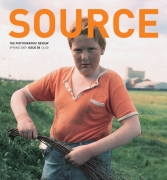The Banks of The Tees
John Duncan talks to Robin Dale
Issue 58 Spring 2009
View Contents ▸
View photographs from: The Banks of The Tees ▸
View video of: The Banks of The Tees ▸
In a collaboration that began in the late 60's Photographer Robin Dale and the folk singer Graeme Miles have produced three major bodies of work as slide sound pieces: The Banks of the Tees, Ballad of a Country Camera and Down the Sands to Whitby Oh! The pieces combine photographs and drawings projected as slides, folk songs and recordings in the field. Robin Dale discussed the background to the work with John Duncan.
Robin Dale: About 1968 I saw an advert for a second-hand Rolleicord, an old style camera where you bowed down to people and gazed at this two and a quarter inch square image. It wasn't as threatening as cameras are now. To increase my knowledge I joined a camera club in Middlesbrough and I came across things called 'slide battles' (I thought 'do they throw slides at each other?'). I learned some things but I didn't want to carry on because everyone else seemed to think that you weren't that good unless you had the latest lens.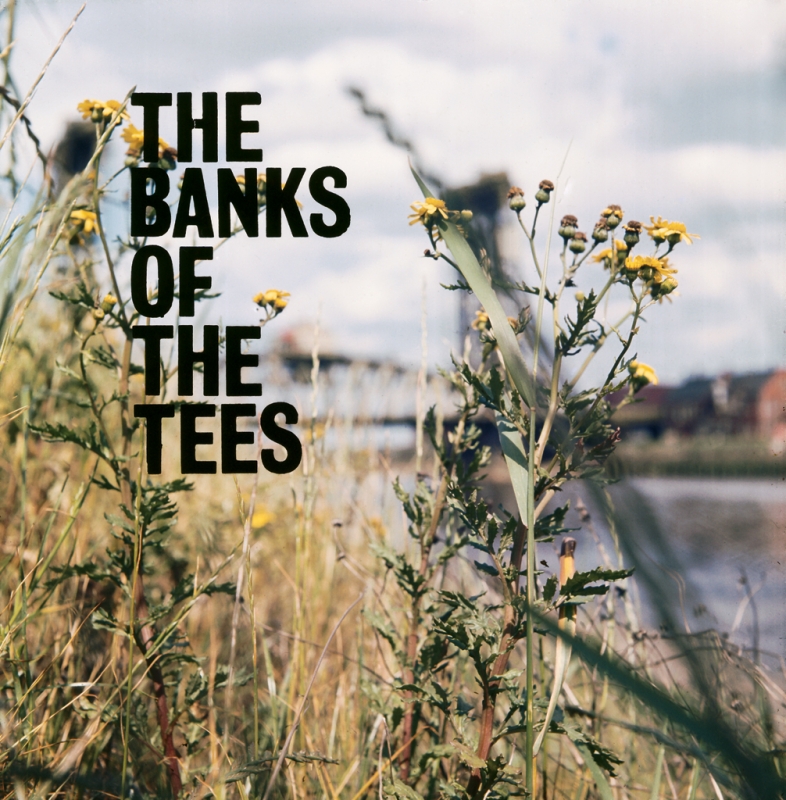 Opening slide from The Banks of The Tees.
Opening slide from The Banks of The Tees.
Then, I bought one of the early slide projectors - you could buy them second-hand - and that opened up an even wider world for me because I'm a frustrated film maker. I would put a sequence of pictures together and add a soundtrack which was usually from the Four Seasons, and I got quite good feedback from that.
John Duncan: Were you influenced much by other photographers or film makers?
Robin Dale: I'm a great film fan and in those days, before video, where I worked at ICI had a film club and it would screen Bicycle Thieves or Wild Strawberries. Some of it was a bit heavy but the photography was great. It wasn't Bruce Willis shooting three hundred men, there was a love of the images. But I realised that I couldn't go down that line because it was a whole new ball game: you'd have to have a script and a sound man and sets. So as much as I liked film I tried to be true to what I could actually do myself.
John Duncan: Could you describe the set up that you use for your projected pieces?
Robin Dale: I first started in this format in 1968 when the most advanced set-up was the automatic carousel or projectors dissolving into one another. But I started with what I term the 'magic lantern style' i.e. push one slide in and manually pull it across and put another slide in, and so on. I like that style and I have remained faithful to that procedure since the early days. What I'm trying to do is push the limits as far as I can using basic, albeit high quality, equipment. I like the idea that if both your senses are used, your eyes and your ears, and if it's done well, you don't see the gap. For example, I would have a light box to see the slides and if you had a sequence of a horse race I would say 'Right, first a general view of the race course, then the tic tac man, the horse race, the fall, the winning enclosure and the man paying out the money.' I could see a filmic story there and I would put that to music.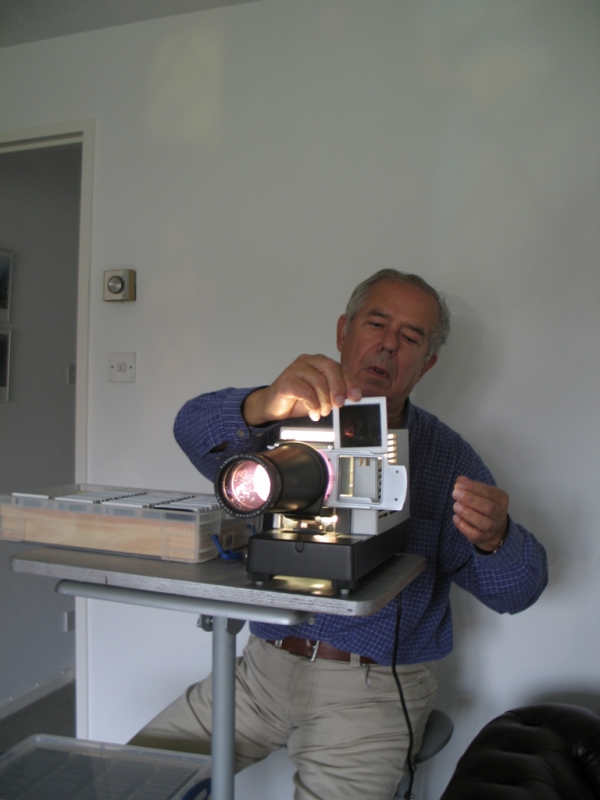 Robin Dale operates his slide projector.
Robin Dale operates his slide projector.
I had just started to do that when I met Graeme Myles in 1968. He has a wonderful ear for sound: Graeme was involved in the early BBC Radio Ballads.
John Duncan: How did you meet Graeme?
Robin Dale: A girlfriend of mine knew Graeme's girlfriend so I was introduced to him that way. He introduced me to a group of like-minded people: you'd go to parties and there were no drugs, but in the small hours you'd all sit round and this lovely music would come out. That's where I fell in with Graeme's writing; it's based on first hand observation, not someone in a garret thinking 'Oh, I'll write about coal miners'. He deliberately went out to source this oral record of what was happening: the lingo of somebody who'd put a bet on and lost, or somebody's wedding, and he'd sketch at the same time. When he moved into the countryside, to North Yorkshire, he would often go off into the moors and set off walking back to Teesside, in the depth of winter, in a shirt and a tweed jacket. When the weather became too bad he would huddle down with the sheep behind the stone walls. So when he writes about the weather on the moors it's because he's experienced it.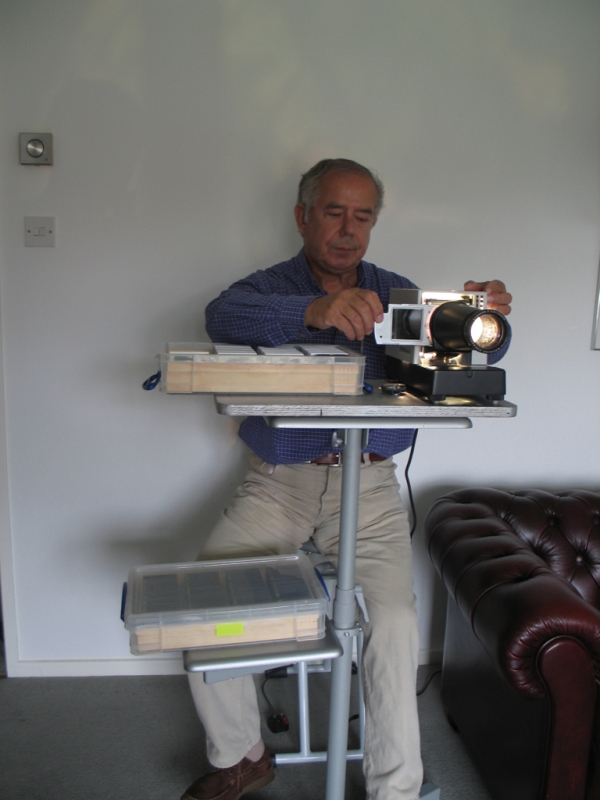 Robin Dale operates his slide projector.
Robin Dale operates his slide projector.
I was interested in the landscape that I grew up with, which was Middlesborough or Stockton. When you're a child you think that it will be there for ever but the late 60s, early 70s - as with the rest of the country - it was losing its heavy industry. The banks of the Tees used to be lined on both sides with small foundries, each putting out high quality but small batches of work, and there was ship building and things like that. So we were gradually losing our industry, but also the streets of terraced houses in Middlesbrough, Grangetown and Stockton - which were built for the workers - were also being pulled down.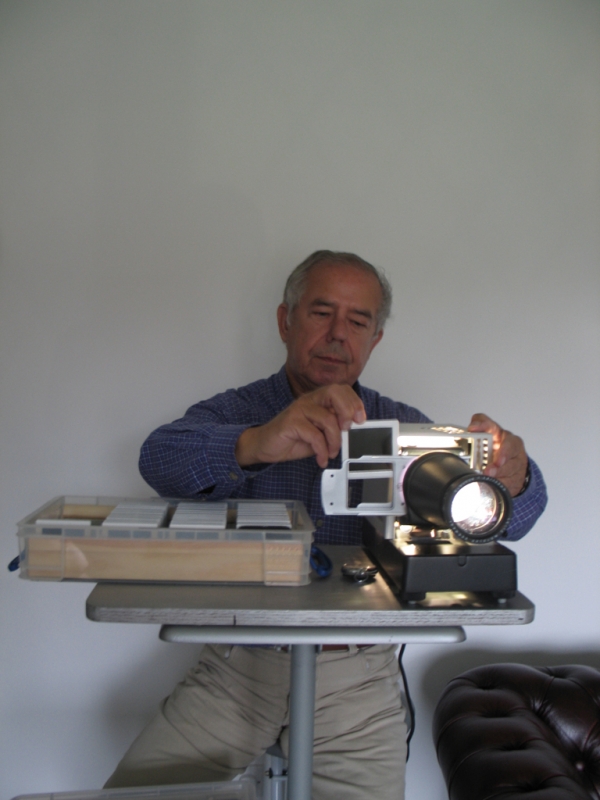 Robin Dale operates his slide projector.
Robin Dale operates his slide projector.
I was looking at the people who lived and worked there and their social life - be it a day at the races or somebody's wedding - and Graeme had been writing about the same subject. So we had a whole range of Graeme's songs and from that we would work out some kind of storyboard.
John Duncan: This is The Banks of the Tees. What was the idea behind the initial sequence of images?
Robin Dale: We made an obvious start: on the river Tees in early morning. Graeme, using the lettraset, started to painfully and carefully put on the various quotes i.e. a quote from Joseph Conrad. We used these as an entrance to the project itself and we set the scene on the banks of the Tees. From there we moved to the shipyard where I clambered on board some of the floating cranes and other equipment in the docks. Having completed the dockyard study and introduced figures it was a smooth run to introduce industry and in this case one of the last small working foundries in Stockton on Tees, Brown's foundry.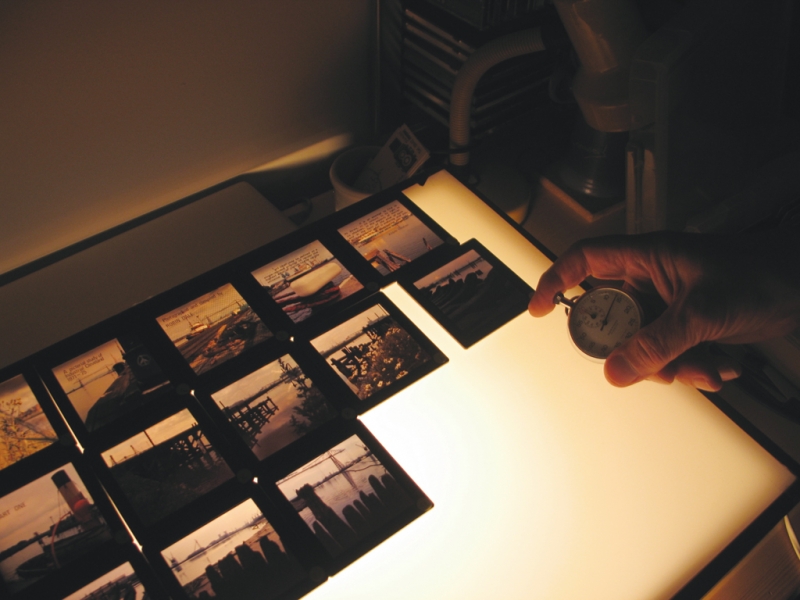 Robin Dale starts his stopwatch with slides ready on a light box.
Robin Dale starts his stopwatch with slides ready on a light box.
I'd spent a day in the foundry so I'd a large body of work from the early morning shift through the daytime - working through the procedure of lighting the furnace, or taking some of the work out, checking it, filing it and tying on tags for the finished job - and then finally people leaving at the end of the shift. We would focus on one man who was setting up the furnace loading it up from a huge truck of coke. So you would see him quite a distance away and then it would move in a bit closer so after about four shots you had got into the rhythm of the work itself.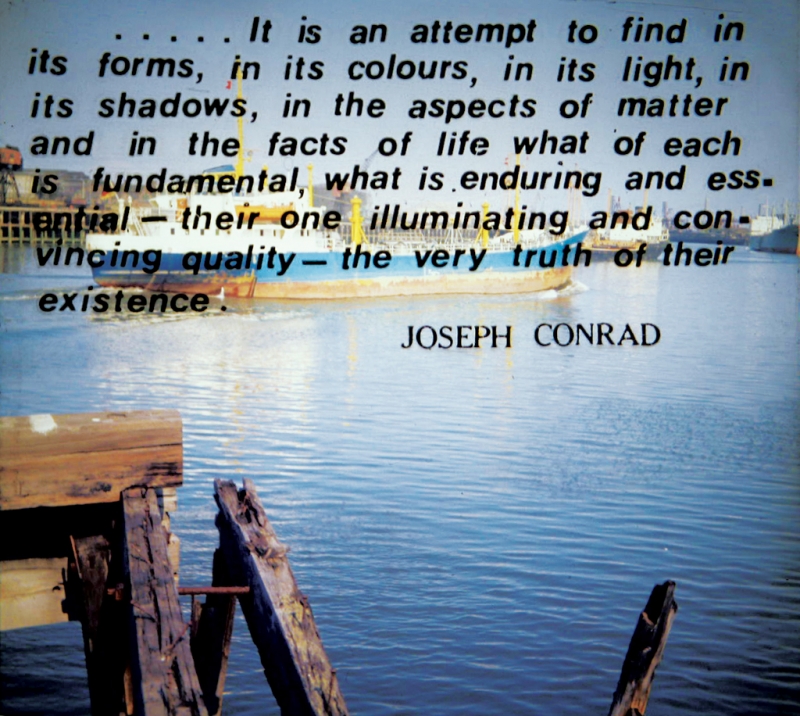 Opening slide from The Banks of The Tees.
Opening slide from The Banks of The Tees.
During this part you would have some music concrète, a mixture of music and sounds that Graeme had produced to give it an almost sinister or heavy sound. This would fade in and out with the sounds of people who actually worked in the foundry talking about the dark working conditions and the heat from the furnace. And if you combined that narrative, about the heat, with a picture of the furnace, then the whole point of the series becomes quite clear. We also combined the inside shots with Graham's drawings, made in a foundry during those early years. Then Graham's song Foundry Man by Trade would be brought in. This was the 70s and safety wasn't quite up to the mark. That was accepted in those days but to emphasise it we would also have a soundtrack of people talking about accidents that would happen.
John Duncan: Would Graeme play live with the projections?
Robin Dale: No. To start we would say, 'We'll want the river first obviously, because that's the subject,' and I would put out, on the light box, about twenty slides. Then Graham would say 'Let's start with the sound of water,' and - because in those days we hadn't got a mobile tape recorder so we couldn't go down to the water - we used to fill the bath. Then Graham would come on with the solo vocal and guitar singing 'It's the banks of the Tees, I remember right well'.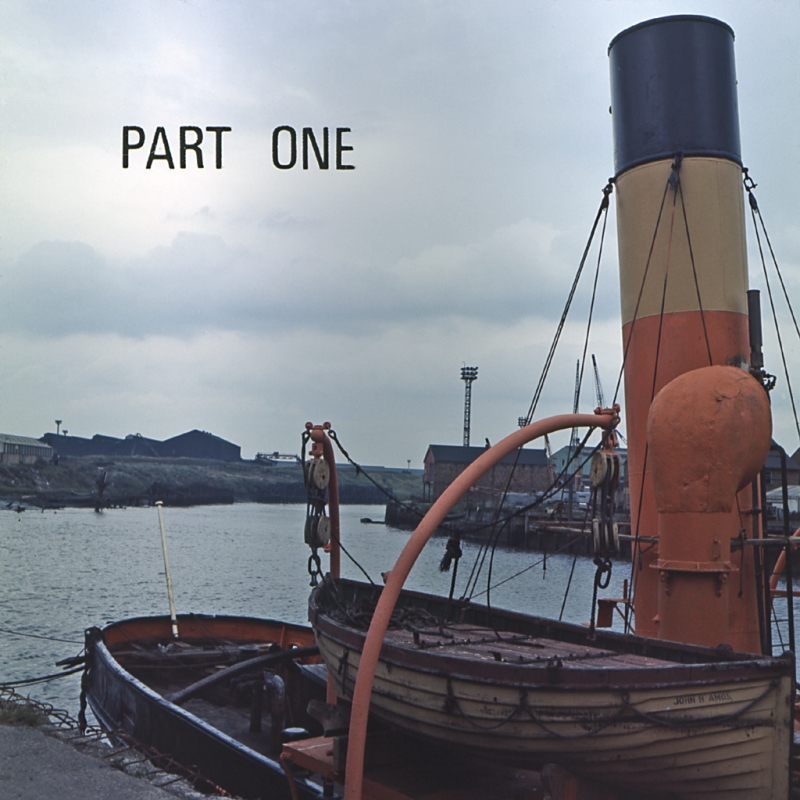 Opening slide from The Banks of The Tees.
Opening slide from The Banks of The Tees.
We had a script of three or four people including a woman's voice singing. You would progress from them to the docks, which was quite busy, and then into the foundries, into the darkness and the noise. Here we would bang on poor Graham's radiators: 'There was a steel hammer up at the forge which used to be going all day long, thump thump thump'. And then there was a song about the life of an iron worker. So you see how it worked...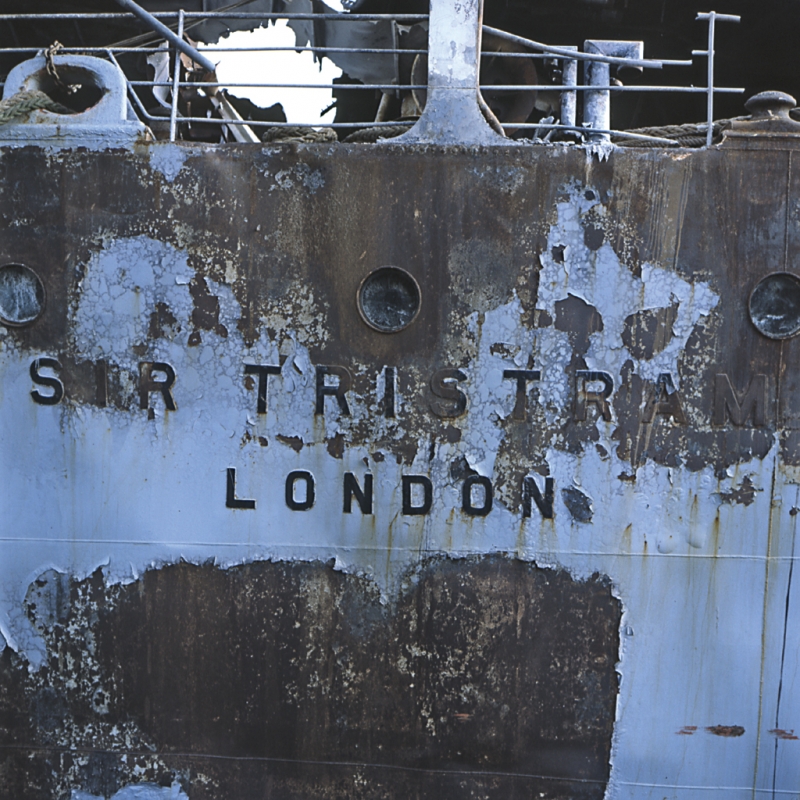 Photograph of the damaged ship the Sir Tristram on the Tees in 1983.
Photograph of the damaged ship the Sir Tristram on the Tees in 1983.
Then at some point you might perhaps go onto the terraced streets and with a microphone out the door I would record children playing, the dad shouting 'come on Howard, come in now son, put that down', you know that lovely sound which you can't fake. And I would bring in the odd picture of children playing in the street. It would go on like that and then you'd see how the kids used to tie up the church gates to get pennies and then you're in to the wedding sequence: we taped some bells off the BBC and then right on cue came Willie Tete and his bride.
John Duncan: When you put together the images for the first time were you thinking about projecting them at a folk club?
Robin Dale: We had no market as such, and we got no financial help. No one was saying 'Oh yes you can come photograph this and we'll give you an exhibition or show'. It was totally self-financed. We were just wanting to put Teesside, as it were, on the map, visually and music-wise. We were both working full-time in ICI, so it took five years to do this project. The folk clubs were an obvious outlet because of Graeme's songs and the music. 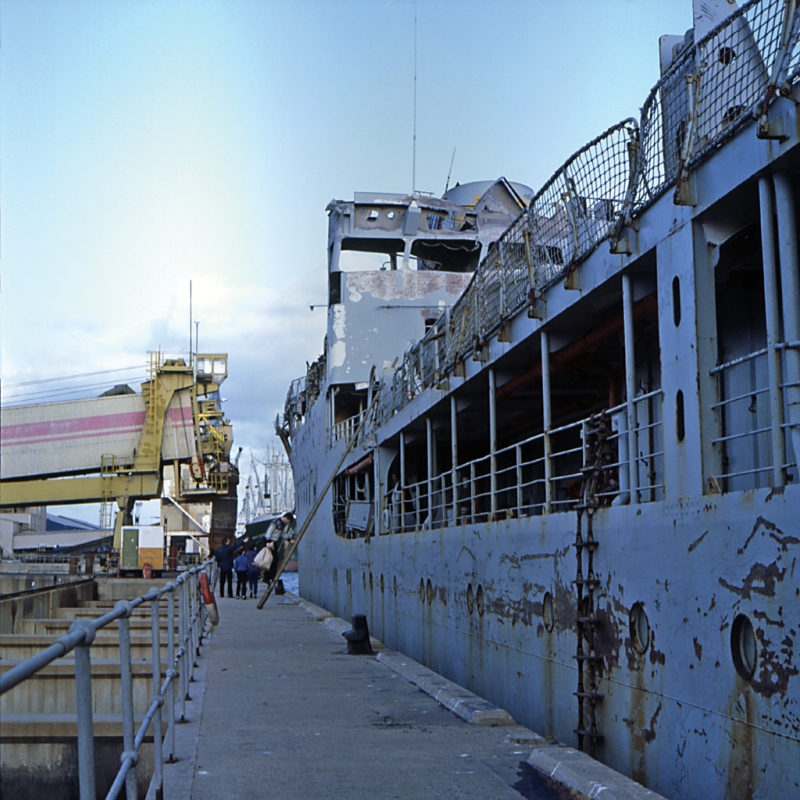 Photograph of the damaged ship the Sir Tristram on the Tees in 1983.
Photograph of the damaged ship the Sir Tristram on the Tees in 1983.
One of the earliest, public showings was back at that camera club that I'd written off. I was still in touch with them and I thought 'Right, I'll show them', and without any preamble I turned up and showed this full length Banks of the Tees which is Part One, one hour, and Part Two, 40 minutes (Graeme initially wanted it to go on for four hours but we found no matter how good the images are there is a limit to what a person can take in). I remember there was a stunned silence. This sort of documentary style - which no one else, to my knowledge, was doing at that time - left them flummoxed.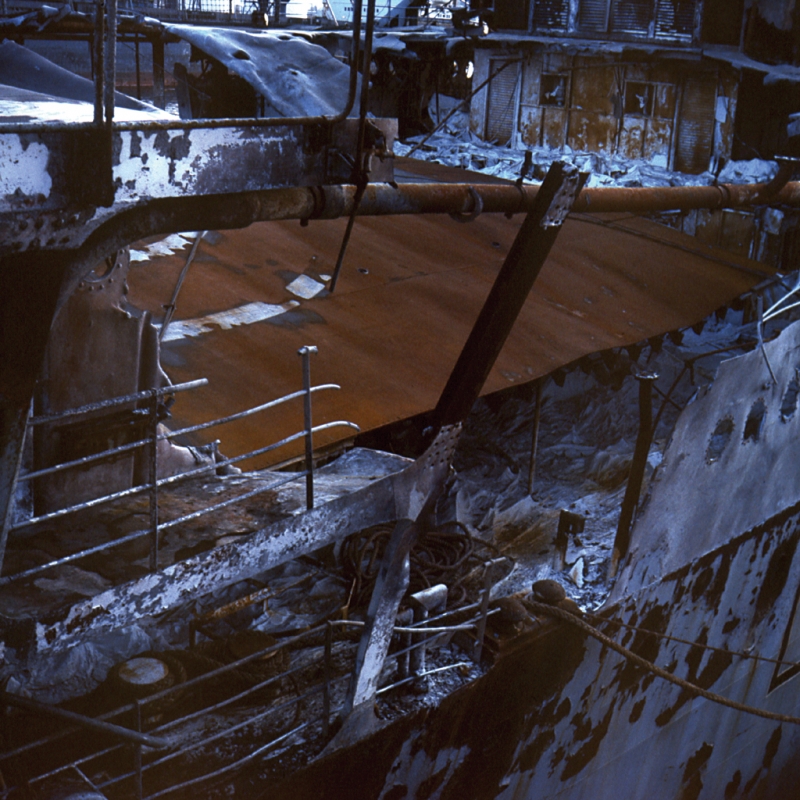 Photograph of the damaged ship the Sir Tristram on the Tees in 1983.
Photograph of the damaged ship the Sir Tristram on the Tees in 1983.
So apart from that I did make a list of places: folk clubs, retired men's clubs, colleges, art societies... a full range of places, except I was always wary of camera clubs.
John Duncan: You were manually changing the slides, were there any mishaps or did that always go smoothly?
Robin Dale: There was always that 'Oh no, what's going to happen if I drop a slide,' or 'What's going to happen if it's upside down.' But that's the risk you take, that's the excitement of a live performance.
John Duncan: What did you have to do to play at the various venues and clubs?
Robin Dale: Often we were invited to go, so we weren't imposing ourselves. Someone had perhaps seen one of our shows in another venue and were a member of a club and passed it on to his group; whether it be an arts study group or a workers education office. The host or secretary of the evening would say 'We are now going to have a little slide show from Robin Dale'. I would go to the front of the hall and give them my introduction spiel and I would volunteer somebody to work the house lights. Graeme would be on sound. After the introduction and everyone had shuffled and settled down I would make my way to the hand operated projector, which would all be set up. Then I'd say 'Sound!' to Graeme and he would hit the sound lever on the reel to reel tape machine. It would start whirring and I would say 'Lights!' to the volunteer on the lights, and with the first clue on the sound track I would hit my stopwatch and off we would go.
John Duncan: Did you make posters or flyers for yourselves?
Robin Dale: No, we were ever so polite, we never canvassed. When you got a group of thirty adults about five of them would be in some kind of organisation. They would come to see one of your shows and then they would say, 'I'm in the Workers' Education' and so on... Graeme's mate Ron Angel knew someone who was in the Labour party in Middlesbrough and Ron knew my work, and it's slightly labour solidarity, so he would have a word with the labour organisation, hence you'd get invited there as well.
John Duncan: You mention labour solidarity. Were all three pieces political?
Robin Dale: No, it's just the feedback I got. I didn't intentionally make a labour manifesto but because it focused on workers, working conditions and lifestyle, then it's bound to have that kind of background. The second one, Ballad of a Country Camera, is rural and we touched on farm workers' conditions which is what The Woeful Scarecrow song was about. Graeme was using the scarecrow as a metaphor for the farm worker. I didn't know till years later when he said, 'Well that's why I've used that scarecrow, "With less than a paupers clothes to wear and not a penny in pay", and at the end of the sequence, "Surely the farmer will bury me decent when I fall."' But of course farmers treat animals just the same, they just get cast away, job done.
Basically, it's a celebration of this particular north east landscape. I don't think you could claim that there was any particular politics. The coastal study, apart from the opening sequences which is about poor life conditions and sea coal, was just about the joy of the seaside. When I look back at it, I've almost photographed my childhood in a seaside landscape, because it's still got that candyfloss feel to it.
There was one more thing that happened during that period: around 1983 was the Falkland's war. It was about as far from the English coast as you could get, but we included it on the premise that Teesside used to have ship building. By chance one of the naval supply ships, the Sir Tristram, came up to the Tees after the war, still in its burnt state. Graeme's wife did work on the docks and said 'I can get you access'. I photographed the terrifically distorted bridge and burnt things. It was so secret, all you had was that John Knott monologue, 'there has been six casualties'. They quite rightly said, 'You can't put it on the telly because the Argentinians will find out' so you didn't know the sad horrors till the documentaries came out later.
So it was a secret thing that I photographed and Graeme wrote a poem about being on the other side of the world and things going on. That gives you different colours: yes there's candyfloss and fun but then, just to jolt the audience, to give them something to think about, you include that sequence.
Other articles by John Duncan:
Other articles mentioning John Duncan:
Other articles mentioning Robin Dale:
Other articles on photography from the 'Documentary' category ▸





